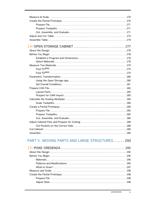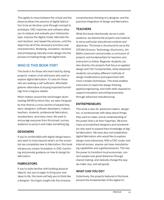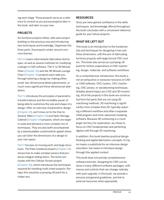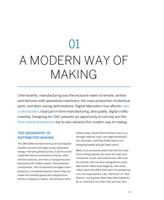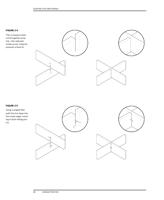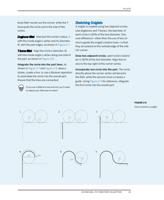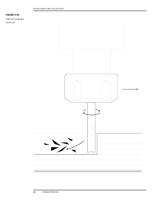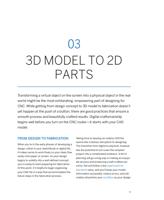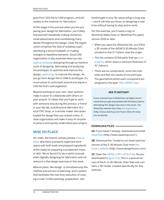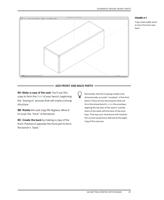
This agility to move between the virtual and the
physical allows the practice of digital fabrica-
tion to be an iterative cycle through concept to
prototype. CNC machines and software allow
you to analyze and evaluate your initial proto-
type, improve the digital model, fabricate the
next iteration, and repeat the process, until the
object has all of the necessary functions and
characteristics. Modeling, simulation, iteration,
and prototyping naturally invite design into the
process of making things with digital tools.
WHO IS THIS BOOK FOR?
This book is for those who learn best by doing
projects: makers of all skill levels who want to
explore digital fabrication. It’s also for those
who are seeking a self-sufficient, affordable,
greener alternative to buying imported furnish-
ings from a big box retailer.
When makers around the world began down-
loading AtFAB furniture files, we were intrigued
by how diverse a cross-section of people they
were: designers, software developers, makers,
teachers, students, professional fabricators,
woodworkers, and many more. We want to
encourage everyone from this broad, curious
audience to jump in and make something big.
DESIGNERS
If you’re comfortable with digital design basics
and want to move beyond what’s on the screen
but are completely new to fabrication, this book
will give you a basic foundation in CNC machin-
ing and provide guidance on how to design for
fabrication.
FABRICATORS
If you’re quite familiar with building physical
objects, but you’re eager to bring your own
ideas to life, this book will help you to think like
a designer. You’ll gain insight into the inclusive,
comprehensive thinking of a designer, and the
practical integration of design and fabrication.
TEACHERS
While this book intentionally serves a wide
audience, we tailored the projects and material
to serve particular educational contexts and
objectives. This book is structured to serve the
STEAM (Science, Technology, Electronics, Art,
Math) classroom and provides a curriculum of
projects and fundamentals for teachers and
instructors to follow. Beginner students can
dive directly into projects that focus on applied
design and CNC fundamentals, while advanced
students can employ different methods of
design modifications and experiment with
more complex techniques. This book enables
instructors to teach the design thinking,
applied engineering, and math skills required to
support innovation and entrepreneurship
through advanced manufacturing.
ENTREPRENEURS
This book is also for advanced makers, design-
ers, or professionals with ideas about things
they want to make, and an understanding of
the power that is at their fingertips. We know
many accomplished designers and woodwork-
ers who want to expand their knowledge of digi-
tal fabrication. We have also met established
digital fabricators who would like to explore
design more intensively. With a CNC router and
internet access, anyone can have manufactur-
ing capabilities and a global presence. This has
the power to transform local economies, con-
nect people over great distances through
shared making, and radically change the way
we make, buy, and sell goods.
WHAT CAN YOU DO?
Collectively, the projects featured in this book
present the fundamentals of the digital-to-
PREFACE
xix













